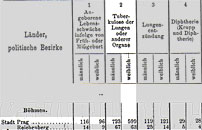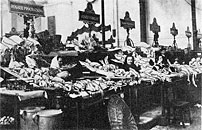Introduction
Analyzing Evidence presents case studies that demonstrate how scholars interpret different kinds of historical evidence in world history. On this screen you see data from the 1910 census of the Hapsburg Monarchy. This data was collected for most towns and cities throughout the Monarchy every few years from between 1880 and 1910. It covers occupation, disease, language, and literacy for men and women separately. You also see a rare photograph of women from Bohemia. Information about women during this period is especially difficult for historians to uncover, and these sources can provide valuable insights into women’s daily lives.
Examine this data carefully. What kinds of information can you gather from the census data alone? What can data on tuberculosis say about women’s social status and daily activities? What can you determine about women’s lives from data on literacy and occupation? What other sources might you use to draw conclusions about women’s lives in Bohemia in the late Hapsburg Monarchy?
Now listen to Professor T. Mills Kelly analyze this census data.
Note: This site uses Flash. For slower connections, visit the non-flash version.




